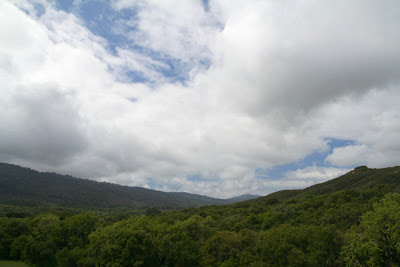When I first started shooting, my photos did not seem to have that 'punch' I was looking for and I couldn't figure out why my DPChallenge entries just didn't look as good as many other photos, even though the subject and composition seemed similar. It was a great revelation to me when I realized that I need to apply more saturation.
What is saturation? Saturation is the purity of the color. White, black, and gray are unsaturated, while a pure red (or any pure color) is fully saturated. Higher saturation means purer color.
The picture below was taken for a DPChallenge landscape challenge but I decided against submitting it because it didn't have the best composition (mostly because it lacks a subject to draw your eye). The only processing I did on this image was resizing and adjusting contrast/brightness.
A pretty nice image, with ok color, but it is kind of dingy. This is pretty much what you get straight from the camera (Digital Rebel XT/350D) although I did use a polarizing filter to clarify the sky a bit.
Watch what happens when I increase the saturation:
Digital photos, especially for the web, need to be adjusted from the camera capture to bring out the color. This is especially true of the default settings of Canon cameras. My theory is that it is a difference between the non-linear sensors in the human eye and the linear sensors in a digital camera.
What about film cameras, though? Well, it is all in the film, and if you want a lot of saturation, you use a film like Fujichrome Velvia.
As a digital photographer though, all this means is you should make sure try increasing the saturation when you are editing pictures. For some pictures, you may want to do the opposite, and reduce saturation or even fully desaturate the image to gray-scale.
Tuesday, April 17, 2007
Quick Tip #2: Saturate your images!
Posted by Sean at 12:40 PM
Labels: DPChallenge, Quick Tip
Subscribe to:
Post Comments (Atom)



No comments:
Post a Comment